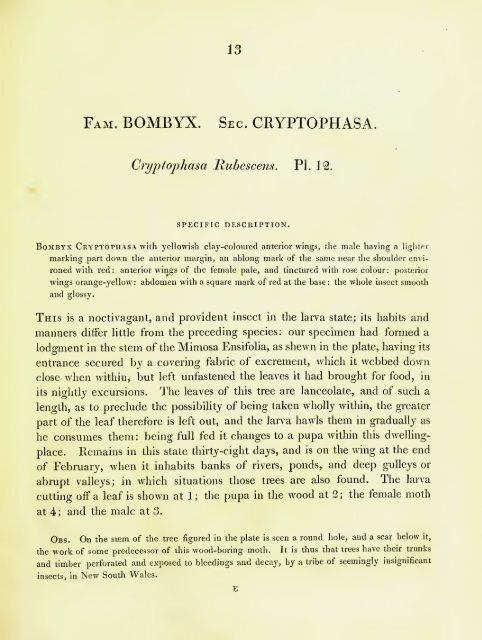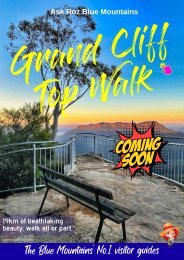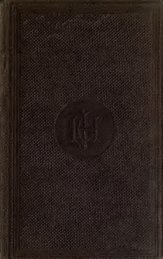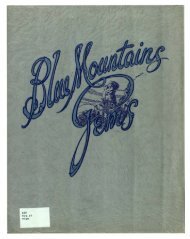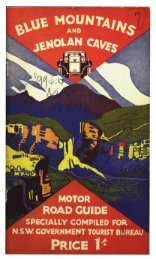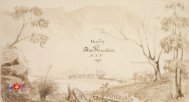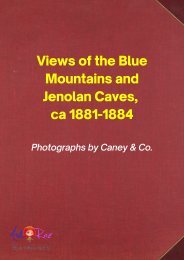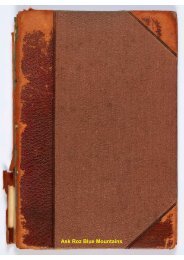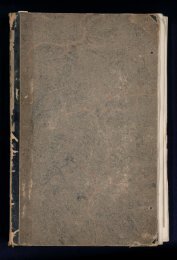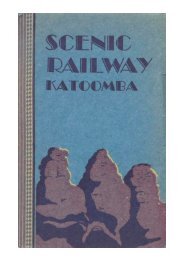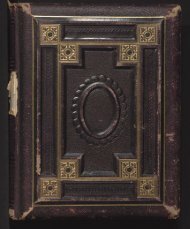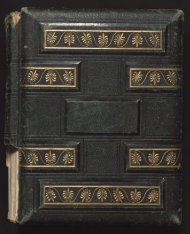A Natural History of Lepidopterous of NSW by John William Lewin
A Natural History of Lepidopterous of NSW by John William Lewin COLLECTED, ENGRAVED, AND FAITHFULLY PAINTED AFTER NATURE JOHN WILLIAM LEWIN, A.L.S. LATE OF PARAMATTA, NEW SOUTH WALES
A Natural History of Lepidopterous of NSW by John William Lewin
COLLECTED, ENGRAVED, AND FAITHFULLY PAINTED AFTER NATURE
JOHN WILLIAM LEWIN, A.L.S. LATE OF PARAMATTA, NEW SOUTH WALES
You also want an ePaper? Increase the reach of your titles
YUMPU automatically turns print PDFs into web optimized ePapers that Google loves.
13<br />
Fam. BOMBYX.<br />
Sec. CRYPTOPHASA.<br />
Cryptophasa Rubescens. PI. 12.<br />
SPECIFIC DESCRIPTION.<br />
Bom<strong>by</strong>x Cryptophasa with yellowish clay-coloured anterior wings, the male having a lighter<br />
marking part down the anterior margin, an ablong mark <strong>of</strong> the same near the shoulder environed<br />
with red: anterior wings <strong>of</strong> the female pale, and tinctured with rose colour: posterior<br />
wings orange-yellow : abdomen with a square mark <strong>of</strong> red at the base : the whole insect smooth<br />
and glossy.<br />
This is a noctivagant, and provident insect in the larva state; its habits and<br />
manners differ little from the preceding species: our specimen had formed a<br />
lodgment in the stem <strong>of</strong> the Mimosa Ensifolia, as shewn in the plate, having its'<br />
entrance secured <strong>by</strong> a covering fabric <strong>of</strong> excrement, which it webbed down<br />
close when within, but left unfastened the leaves it had brought for food, in<br />
its nightly excursions. The leaves <strong>of</strong> this tree are lanceolate, and <strong>of</strong> such a<br />
length, as to preclude the possibility <strong>of</strong> being taken wholly within, the greater<br />
part <strong>of</strong> the leaf therefore is left out, and the larva hawls them in gradually as<br />
he consumes them: being full fed it changes to a pupa within this dwellingplace.<br />
Remains in this state thirty-eight days, and is on the wing at the end<br />
<strong>of</strong> February, when it inhabits banks <strong>of</strong> rivers, ponds, and deep gulleys or<br />
abrupt valleys; in which situations those trees are also found. The larva<br />
cutting <strong>of</strong>f a leaf is shown at 1; the pupa in the wood at 2; the female moth<br />
at 4; and the male at 3.<br />
Obs. On the stem <strong>of</strong> the tree figured in the plate is seen a round hole, and a scar below it,<br />
the work <strong>of</strong> some predecessor <strong>of</strong> this wood-boring moth. It is thus that trees have their trunks<br />
and timber perforated and exposed to bleedings and decay, <strong>by</strong> a tribe <strong>of</strong> seemingly insignificant<br />
insects, in New South Wales.


